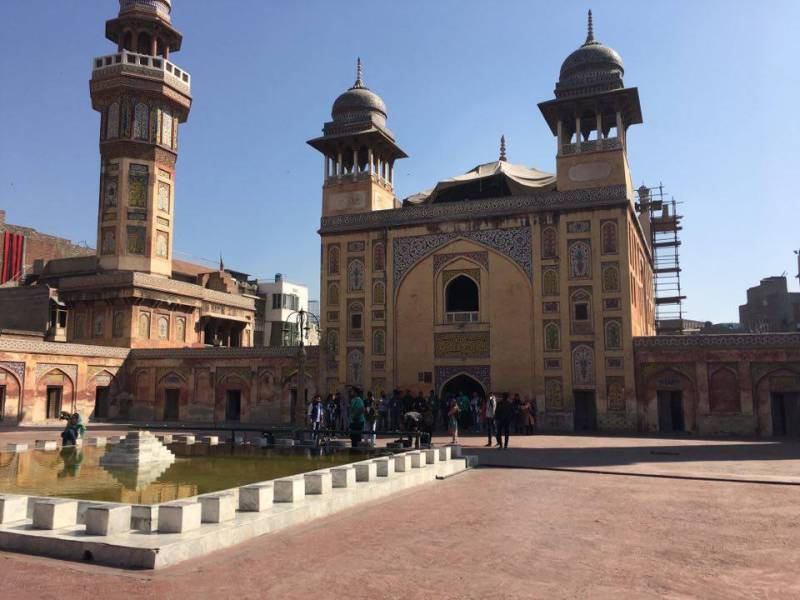Wazir Khan Mosque; easily the most beautiful mosque of Lahore which has been described as a beauty spot (mole) on the face of the city.
After entering the city through Delhi Gate the mosque can be reached by going straight through the narrow and busy Kashmiri Bazaar. The mosque is a Mughal building but was not built by a Mughal king.
This credit goes to a man called Sheikh Ilm-ud-Din Ansari who was originally a Hakim (physician) from Chiniot.


The legend says that he came into limelight when Queen Noor Jehan developed an abscess or something on the sole of her foot. It was painful to walk but she was so embarrassed that she wanted a physician to treat it without looking at it or touching it! Also treatment failure was to be punished by death so no one dared but Hakim Ansari did. He first filled a hole in the floor with wet mud and asked the queen to step through it, after that by studying the foot-print he was able to localize the lump, he then placed a tiny sharp blade or something at the spot where the lump was and the queen was asked to step in the mud-hole and then walk briskly for few minutes. The abscess was thus punctured providing the queen instant relief from pain and as she walked around all the puss etc got squeezed out. She was so pleased that Hakim sahib became a millionaire.
He also became a close friend and physician of Prince Khuram who became the Emperor Shah Jehan. When Shah Jehan's favorite wife Mumtaz Mahal died in Burhanpur, Hakim Ansari was entrusted with taking her body for burial in Agra 1,000 kilometers away.
Eventually Hakim Ansari became the governor of Lahore and was known as Wazir Khan. He used his personal wealth to build the mosque named after him, it took seven years to be completed 1634 to 1641 under his personal supervision.


The striking feature of the Mosque is the use of glazed mosaic tiles and frescos both outside and inside. This is a common feature of Mosques and tombs in Iran and Central Asia but quite rarely seen in the subcontinent. In fact it is only in Punjab and Sindh that buildings have this ornamentation and curiously, although these were built in Mughal times, they were not built by the monarch himself but by princes and nobles of his court. Some architects call this Lahore specific architecture in Indian sub-continent and nowhere in this region can one find a better example than Wazir Khan Mosque.
The art on the walls is considered so important that John Lockwood Kipling who was the first director of Mayo College of Art (now called National College of Art) made all his students spend time studying it. According to him this is one of the few examples of real Fresco painting (Buno Fresco) in the world.




No wonder the Mosque catches the imagination of writers who have based their stories in Lahore the most well known of them being John Kipling's famous son Rudyard Kipling. It was while he was living in Lahore that Kipling (who at the age of 42 became the first English language writer and the youngest recipient of Noble Prize) published his first collection of short stories and the very first story The Gate of a Hundred Sorrows, describes the location of an opium den within 100 yards of Wazir Khan mosque. In another of his stories titled City of Dreadful Night he describes people sleeping like dead (probably intoxicated) in the square in front of the Mosque and one had to walk with care so as not to step on them.
Kipling's writings no doubt inspired another writer Jorge Borges to base his short story Blue Tiger written in 1977 in Lahore. The story about mysterious self-multiplying blue stones that bring the narrater to the brink of insanity ends at the Wazir Khan Mosque as he writes:
''Inside the mosque, it occurred to me that God and Allah are two names for a single, inconceivable Being, and I prayed aloud that I be freed from my burden.''
His prayers are answered as a blind beggar takes the stones from him and tells him to keep his sanity. Borges did not base this scene in Wazir Khan Mosque at random but due to the well known benefits Sufi mystics give to insanity to unburden themselves from the demands of the physical world and devote totally to God.
It is worth noting that within Wazir Khan Mosque are the graves of not one but two Sufi Mystics.
As the saying goes, ''He who has not seen Lahore is not born'' I would add, ''He who has not seen Wazir Khan Mosque has not been to Lahore''










